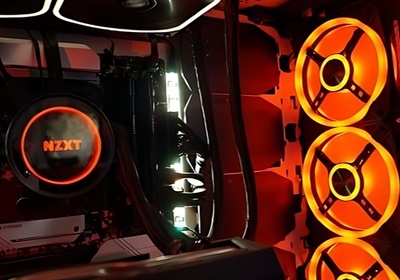The right PC fan control - How to control the PC fan

So you’re totally satisfied with your PC, but there’s something that really irks you: the sound of the fans. Even when you don’t put too much load on your computer and only run simple office applications, the fans in your PC operate at a very annoying volume. Good ventilation of various components in the PC is of course very important, as is the ventilation in the case. Still, you may wonder whether it’s possible to reduce this noise a bit by controlling the fans yourself. The answer to this question is: Yes, it is possible. Our post explains how you can control your PC’s fans and what you should keep in mind.
- How can you control your fans?
- How can you change the speed of the fans?
- Can my laptop’s fan be controlled?
- How fast should a fan rotate?
- How many fans should a normal PC have?
- Can you make your fans quieter?
- How many fans should a gaming PC have?
- Why have the fans have become louder?
- How does fan control work?
- How can you tell which fan controller you need?
- When should you replace your fan controller?
- What indicates that you should replace your fan controller?
- Conclusion
- Discover our product recommendations
(PC fans: Find out in the video, how many case fans do you REALLY need & more | 10 Min))
There are several ways to control a computer’s fans. Generally speaking, fans like the CPU fan don’t have a constant speed. The same goes for many case fans. The speed of these fans is determined by the temperature of the CPU, for example. If a lot is demanded of the CPU, the processor also has to work more. More heat is then generated, and the fan also has to work harder to dissipate this heat. The motherboard controls most fans, but there are also ways to increase or decrease the fan speed. One option is the free software called SpeedFan, which is able to read S.M.A.R.T. data and control the speed. This can even be done automatically. The tool measures various temperatures, including those of the CPU, power supply, motherboard, and more.
Alternatively, it’s also possible exert control in the BIOS. There are some motherboard manufacturers that allow the fan speed to be controlled in this manner. However, this doesn’t work with all motherboards. There is another way to regulate the fans, though, and it comes in the form of a hardware controller (which has to be purchased separately). Alternatively, adapters can be used that provide less voltage to the fans that are installed in the computer.
It should be noted that these adapters are usually not intended for PWM fans, but rather for models that have a 3-pin connector. These can be regulated accordingly via the speed’s voltage.
Control via SpeedFan
The fastest option is the SpeedFan tool. This program is free and lets you regulate the fan speed with just a few clicks. Before using SpeedFan, it is best to deactivate the fan control in the BIOS/UEFI. There also shouldn’t be any other motherboard software installed that is used to control the fans. Otherwise, it is possible that a conflict with SpeedFan will arise. Furthermore, the latest drivers for the motherboard’s chipset should be installed. Here’s how to do it:
- Open the program and you will see the “Readings” tab. A list of all the fans that are installed in the PC can be found in the lower area. Behind each individual fan, you can read the percentage at which it is currently running.
- The speed can easily be changed by using the arrow — just click on it to increase or decrease the speed. It is also possible to simply enter the desired number in the available field.

BIOS control
Important: If the mainboard allows the fan speed to be controlled, here’s how to proceed:
- Open the BIOS and carry out the corresponding settings. In many models it’s possible to enter very specific speeds for different temperature ranges.
- Generally, the speed is always indicated as a percentage here. Most fans operate in a range of 30 to 100%.
It isn’t possible to completely turn fans off in the BIOS. It’s not advisable anyway — otherwise, damage can occur.
Regulate with fan control
There are various fan controllers that can be used instead of the software solution. However, it should be noted that they can only be used with desktop computers. Starting at €15, fan controllers are relatively cheap. They’re also easy to install.
All that’s needed for installation is a free drive bay into which the device can be pushed. After that, it’s connected to the motherboard. Once the installation is complete, the fans can be regulated on the front of the controller.
A short breather - Popular products in the spotlight

It’s also possible to control a laptop’s fan. Programs like SpeedFan can also be used for laptop fan control, and it is also possible to regulate the fan speed in the BIOS. However, since cooling plays a big role for laptops in particular, you should definitely make sure that the speed isn’t turned down too much.
Otherwise, the device can overheat very quickly and get damaged. Alternatively, it’s also possible to lower the maximum clock rate of the CPU in the device’s energy options. The processor then runs at a lower clock rate and thus doesn’t get as warm. The fan doesn’t have to start as often.
However, it’s important to know that the laptop’s performance also decreases. Those who use demanding applications or regularly play games on it would be wise not to use this option.
It’s difficult to say because it always depends on which computer it is installed in. It’s important that the fan’s minimum speed not be too high. Particularly quiet models work with 500 rpm or less. When taxed, most fans manage with 1000 rpm. If the computer is heavily used, a fan can even reach between 1200 and 1500 rpm. It’s clear that PCs that are heavily used can’t get by with too low a fan speed. Good ventilation is necessary to ensure performance and avoid damage. If you often demand a lot of your computer, you should be ready to put up with more noise. Fans in PCs that are only used for office applications can also work with 500 rpm.
Again, it depends on what kind of PC it is. The number of fans always depends on the respective case. With simple PCs, one can usually expect that besides the CPU, which is always equipped with a fan, the power supply and the graphics card also have a fan.
There are, however, exceptions. A case fan is usually only practical and recommended when many high-quality components have to perform very well on a daily basis. Think gaming PCs, for example.
At best, the number of fans in the PC should depend on the space available in the case and the cooling performance that’s required.
Can you make your fans quieter?
When a fan runs slower, it doesn’t produce as much noise and is thus quieter. This means that by controlling the fans, they also automatically become quieter when the speed is reduced.

In most cases, there’s only one reason why the fans get louder: They are dirty. Dust and dirt settle on the fans over time, causing them to get clogged up. Especially behind the fan and between the individual blades, quite a bit of dirt accumulates the more the computer is used. Of course, it’s also possible that the fan is simply defective — in which case a replacement becomes necessary. Fans that are too busy or too weak to perform the tasks assigned to them are also very loud.
There are many components in a gaming PC that are important for a smooth gaming experience. Besides the processor, graphics card, power supply, and motherboard, the cooling system also plays a major role. If the cooling system is not sufficient, the performance drops and the games can no longer be played smoothly.
Special gaming PCs are usually already delivered with various fans. Each CPU has a fan, but in a gaming PC, the graphics card and power supply are usually also equipped with their own fan. In most cases, however, this is by no means sufficient for a gaming PC.
Since the abovementioned fans are located inside the case, there has to be an airflow to supply them with adequate air. This is where a case fan comes into play. A high-quality gaming PC shouldn’t only have one case fan.
Ideally, it will have several. It should be ensured that fans that bring fresh air into the case aren’t all that’s being used — corresponding fans that dissipate the warm air again ought to be used as well. Between two and five fans should be installed in a gaming PC.
(Find out how many fans a gaming PC needs and how to maximise performance | 10 Min)
If fan control software is to be used, everyone must decide which program they want to use. For many, the best tool is called SpeedFan. It is also available for free. There are of course other tools that can be used to control the fans. If you are familiar with the BIOS, you don’t need a program at all — simply use it to control the fans. However, you should have some proficiency in this respect. If you don’t want to use any software or change anything in the BIOS, the only remaining option is a separate fan controller that’s installed in the computer before use. When it comes down to it, the type of fan controller that’s chosen is merely a matter of taste.
Fan control works quite simply: By setting the speed of the individual fans up or down, they are regulated. Within certain parameters, the fans can be set so that the speed is lower or higher.
If it’s set lower, the fan volume simultaneously goes down. If it’s set higher, the fans become louder, but the cooling performance increases in return. To avoid damaging the PC, you should simply ensure that the speed is never set too low.
If a separate fan controller is used, it only needs to be replaced when the device stops working or the user isn’t satisfied with its performance. The same applies to programs that are used for regulation commands. If one program isn’t performing up to par, simply try another one.
A fan controller is only an additional component that usually isn’t included in a PC’s scope of delivery. This being the case, only users who have installed such a controller have to be aware of it. If the fans can no longer be controlled using it, it’s obvious that the controller no longer works and should be replaced.
You don’t have to put up with loud fans that run constantly for no reason. If you’re annoyed by the volume of the fans in your PC, you should try to control them yourself. Not only will this allow you to make sure that they run much quieter, but you can also increase their speed and provide more ventilation. Fan control gives you a lot of options to influence your PC so that you can truly get the most out of it. The only thing that’s crucial is that you make sure not to overdo it when setting the temperature. Always set your fan control according to the installed components and be prepared to accept somewhat louder noises rather than risk damaging the PC [➤ Return to table of contents].
